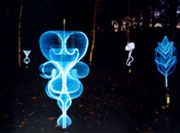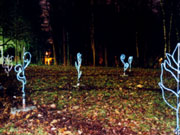
Integration
of digital media with physical spaces acknowledges and uses the advantages
of both physical and computational domains: the full sensorial immersion
of the physical plus the malleability and responsivity of the digital.
One of the artistic productions that puts some of this research into practice
is txOom, a responsive environment founded on "recycling" media,
materials and behaviors from one form to another.
Influenced
and enticed by the human behavior, the design of audiovisual media and
real-time media synthesis mechanisms of txOom should result in an adaptive,
responsive environment. The system driving the environment is engaged
in autonomous evolution, that is guided (fertilized or infected) by the
actions of its users. This system is designed in a way that will allow
artists and engineers to engage the local communities in the design of
the media and materials for the site-specific installations. These groups
will aid the adaptation of the designed, responsive environments to the
local situations, allowing them to blend with natural, industrial or historic
spaces, whose context is very well known to the local people. The aim
of the project is to make these spaces 'grow' with media and become more
'flexible' and adaptable to the social interactions of their visitors.
In 2002 the txOom environments will be temporarily integrated into public
spaces, such as abandoned an military installation in Torino, Italy, an
old Circus Building in Great Yarmouth, UK and possibly the Botanical Gardens
in Vienna, Austria.
Conclusion: Weeding Techniques
"Most of the associations between the living things we know about are essentially cooperative ones, symbiotic in one degree or another..." (Lewis Thomas, 1974)Reviewing the cases that we have introduced in this paper : Hubbub, GroWorld, txOom, we see a few common themes that could be useful for designers of new technologies. In such projects, the media and technologies that we propose should:
- Make the static public spaces malleable, adaptable to the events that take place in them.
- Give physical characteristics to the digital media, allowing a continuous, natural interaction between the physical and the virtual. More specifically, media transformations should appear animate and the interaction with them should be familiar and understandable to the users/participants.
- Design the pattern tracking so that there is no syntactic filter, moving beyond the valorization of glitch or error (which as an aesthetic stance goes back, in the modern era, to Cage and to Dada). Every gesture, every stroke, every movement should be accepted by the system, with nuanced response.
Integration of cultural, ecological and technological studies will move these projects towards a long term experiment in sustainable creative, technological and sociological development, connecting organizations and individuals from various disciplines and cultures in one common goal: growing an adaptive, sustainable habitat for nature, technology and culture.
So to conclude, what are the strategies or heuristics that we might draw from these examples?
Strategy 1: Turn lattices to water.
Application: street/plaza geometry : the perspective should shift in a gentle rhythm as one moves through the space. This depends on the characteristic speed of course. One precondition may be simply to exclude cars from certain neighborhoods, and provide alternative flow.
Strategy 2: Turn crystal to mud.
Application: Unlike crystal structures – lattices of atoms inhospitable to life, mud houses a riot of bio-processes, micros-organisms, worms and other interstitial life-forms. What we learn upon closer inspection, is that far from being confined to insignificant gaps between crystalline structures, such bio-processes, the wet chemistry, the wet biology, form the bulk of matter. And it is such generic mud that affords the possibility of forming new life sweeping away the simple cuts between life and non-life.
Just so, we can carry such intuitions into technologies of language. We can use speech not for communication of information but as compost, or peat for burning, building, potting communication.
Strategy 3: Minimize borders and maximize edges.
The sustainability of public spaces is dependent on an abundant diversity of social, biological and cultural habitats. Their interrelationships will inevitably grow at the edges of dissimilar environments, such as urban-natural, cultural-scientific, physical-digital. The public spaces of the future should merge the context and the meaning of the local, physical sites with the globally accessible digital media and build trans-local events encouraging interaction between communities on both sides of the digital divide. Maximizing the edges enormously increases the interface between worlds; maximizing the interstitial surfaces increases the chance of exchange, mutual transformation and combustion, a fire that creates life from the conflagration of culture plus science, matter plus symbol.
In his essay, "One More Turn After the the Social Turn," Bruno Latour added a second dimension above the usual axis between nature and society, proposing that we explicitly think about the degree of stabilization of what he and Michel Serres call "quasi-objects." Latour spoke of the construction of scientific knowledge. What we have done and propose to continue is a living art and an art of living out the potential of putting in play the balance between what is natural and what is synthetic.
In fact, GroWorld and Hubbub point to new symmetries that become possible between the natural and the urban in the presence of embedded computation. What's natural is no longer natural, but in light of our experiments, this could be a healthy prospect. A square meter of grass in the middle of the concrete jungle has quite a different set of symbolic and biological values than a square meter in the middle of the forest (or the desert). If we infuse that plot of dirt with sound, and structured light and other media, what we might do is to puncture the skin, that border, between life and non-life. There's the danger of course, that we kill everything within that soil, but there's also the opportunity to animate the inanimate, to enroll deaf and dumb bits into a living system, and breathe irony, laughter, music into the lumpy matter.

Registration of a GroWorld installation in a semi public
garden in Brussels.
December 2000


Video texture developed by Maja Kuzmanovic based on cell signaling of bioluminescent bacteria
(dinoflagelates)
back to sponge >